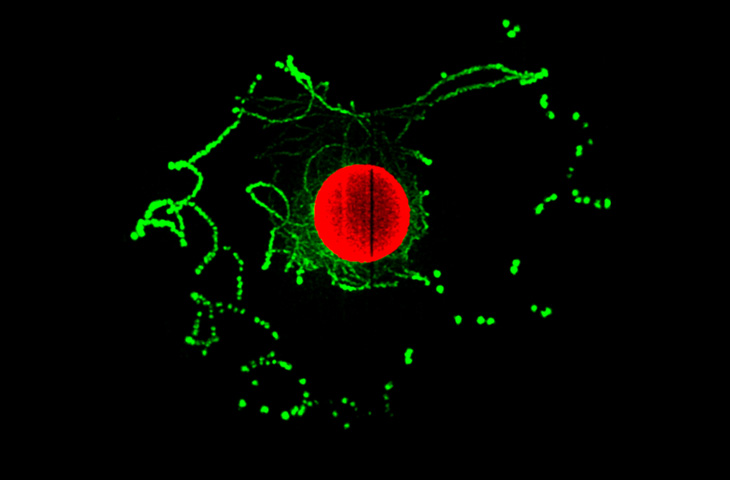Dans les champs de l'observation le hasard ne favorise que les esprits préparés.
In the fields of observation, chance favors only the prepared mind.
- Louis Pasteur
It all started by chance. When Sravanti Uppaluri began learning to culture worms, she made a simple observation. Over a few days, a petri-dish starting with a single patch of bacteria – food for the growing worms – began showing signs of more bacterial colonies blossoming in spots several centimeters away from the original patch. Further investigations revealed that worms would often revisit the new bacterial patches to feed in and reproduce.
Puzzled, she discussed her findings with colleague Shashi Thutupalli, who was at the time, a postdoctoral fellow at Princeton University. Chance found prepared minds digging away at an interesting observation and favoured them with a flash of insight.
It was farming!
The worms were farming bacteria, their food source, much like a farmer sows seeds in new fields to harvest later. And so, the latest entrant into the ranks of the farming community is now a worm. The ubiquitous Caenorhabtidis elegans, which has been used as a model in molecular and developmental biology for over half a decade, has been recognised as an agriculturist.
“We knew that the bacteria were non-motile, that is, they could not move,” says Uppaluri. “And yet, there were new bacterial colonies away from the original patch of bacteria,” she adds.
“So, we reasoned that this happened only because the worm was taking it (bacteria) there,” says Thutupalli, currently a faculty member at the National Centre for Biological Sciences.
To confirm that worms did transport bacteria from one place to another, the researchers placed worms on a small patch of fluorescent bacteria in a dish and observed them. Over several days, worm trails all over the dish were seen to literally glow with new colonies of luminous bacteria.
The bacteria stuck to the surface of the worms to hitch a ride away from their parent colonies. This way, the predatory worms farmed their bacterial prey by carrying them away from crowded areas to new spaces having abundant resources. The fresh bacterial crops were revisited and seeded with eggs by their wriggly farmers, which also served to help the worm population grow.
Non-farming worm populations – mutants to which bacteria could not adhere – faced earlier food depletion and did not grow as well as farming worm populations. In mixtures of farming and non-farming worms, populations with fewer non-farmers had more growth than those with more non-farmers. These mixing experiments recreated a classic evolutionary situation – that of how cheaters (in this case, non-farmers) affect a population dependent on a public food resource.
In a new publication in the Proceedings of the National academy of Sciences (PNAS), Thutupalli, Uppaluri and their collaborators from Princeton University introduce the worm-farming-bacteria as a new system to study complex ecological, behavioural and evolutionary questions such as population dynamics and cheating in the production and use of public goods.
“From the perspective of public goods and their dynamics, this is an extremely cool experimental set-up. The parallels between C. elegans farming bacteria and macro-ecological systems are clear; there is a prey (bacteria) and a predator (C. elegans) that engages in complex foraging behaviour,” says George Constable a co-author who worked on modelling the worm-farming bacteria system. “At the same time the system remains experimentally tractable; a lot is known about the neurobiology and individual foraging behaviour of C. elegans and on top of that the whole experiment takes place within a petri dish!” he adds.
“But it all came from a totally naïve observation. People working with C. elegans must have seen this occurring all the time, but they probably just took it for granted and never investigated what or how it was happening,” says Uppaluri. “What really strikes me about all this is that we are a group of scientists from widely different areas, but we’ve come together to discover a whole new system!” she adds.
The worm-farming-bacteria system also opens up a huge number of complicated biological phenomena that can now be explored on a table-top experimental system. Amongst these are ‘spreading processes’ in nature such as seed dispersal or the movement of an infection through a host population. For example, under some conditions, the dynamics of the bacterial spread across the dish were uncannily like an epidemic advancing via infectious transmission – Thutupalli mentions that a model of bacterial spread based on these experiments resembled that of a rabies epidemic in Switzerland in the late 1970s.
“We're very excited about the theoretical avenues that this opens, especially because this model system will allow theoretical investigations to be grounded into experimental work,” says Corina Tarnita, another co-author who works on mathematical modelling of complex biological phenomena.
“I thought the whole idea was very creative. Rich population dynamics like this, taking place within an experimentally tractable system, makes this a very interesting and exciting avenue,” says Clifford Brangwynne from Princeton, in whose laboratory Uppaluri and Thutupalli made this discovery. “It’s exciting to see that this research has seeded a whole new set of interesting questions and research directions, which will continue to grow and spread just like the worms and bacteria!” he adds.
A part of this article was written as an exercise in writing news stories conducted at the Sixth Annual Science Journalism Workshop. The author thanks Anil Ananthaswamy, Peter Aldhous and all the participants at the Workshop for discussions and comments on the work.
The work described in this article/press release has been published as a paper titled “Farming and public goods production in C. elegans populations” in the journal Proceedings of the National Academy of Sciences and can be accessed here









0 Comments